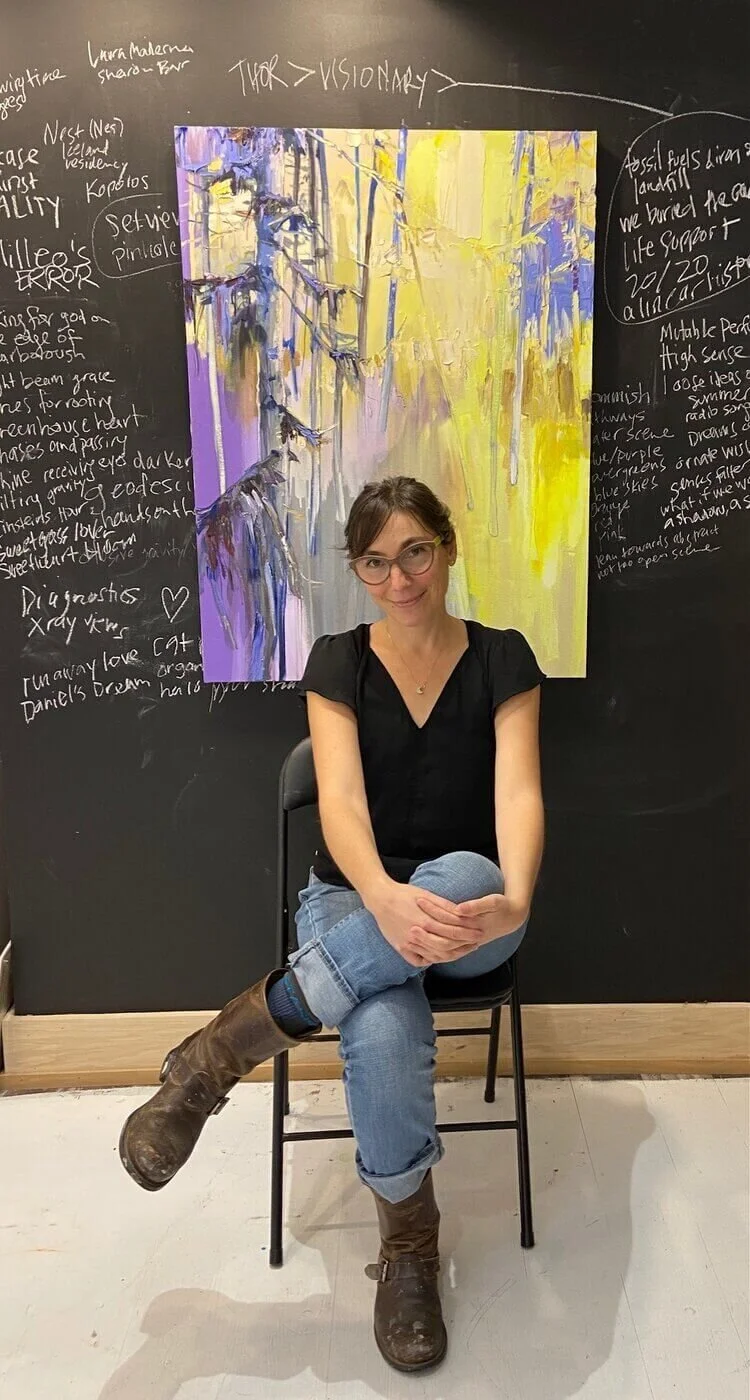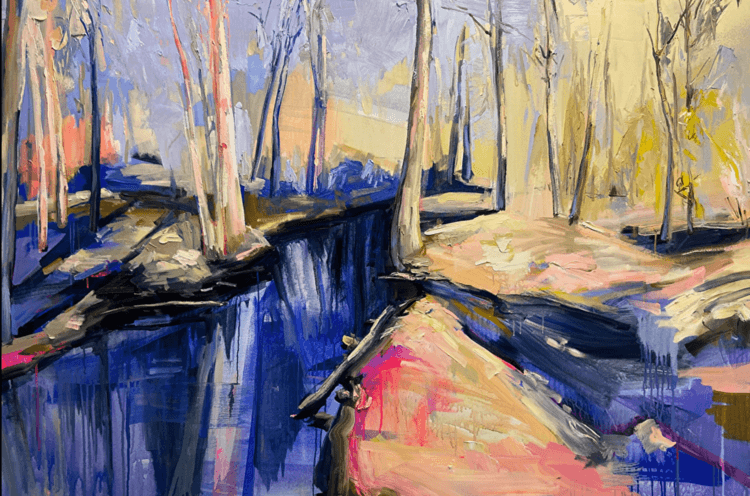Julie Himel: Enviroments Unchanged
Candian Painter Julie Himel is known for her bold paintings of abstracted landscapes. Composed of thick, gestural strokes of color, Julie’s work is centered around the idea of preserving the natural environment in a time of tumultuous change. In this interview, Julie shares her creative process and the inspiration behind her work.
Tell me about your background and where your creative journey began.
I was born and raised primarily in Toronto, Canada with a few year stint in Texas early on. My family moved a lot; different districts and changing schools was part of life. I was always a creative kid, fascinated by the alchemy of colour, the materiality of paint, the magic of turning a line into something recognizable or translating my imagination. I took what came naturally to me and found it was an incredible well to draw on in processing my changing surroundings.
Where do you find inspiration for your work?
A few years ago, I likely would have said that nature inspires me, and it does. But where I stand today, I am looking at the bigger picture and responding to it. The inspiration comes from everything and is a way of being. It’s in what’s happening globally, and also in my own backyard. It's in the spiritual, social, political, economic, technological, and most importantly the environmental state of things. It’s all related. As we find ourselves in this new epoch and we grasp at threads of hope in slowing down climate change, I think about how important it is to document our environment in the few hidden corners where it is largely untouched and unchanged. I look at nature from the perspective of having already lost it and my paintings are passing on the story of what we once had, filtered through memory and nostalgia, lost in translation over time. I suppose a great inspiration is in arts’ ability to influence thought and change, its slow and natural unfolding of information, its delivery of the energy captured in the material process, and the potentiality of bringing all of those elements together in a way that creates a dialogue with a viewer and adds meaning to their lives, perhaps even beauty.
What led you to focus on landscape painting?
I have always maximized my time in nature and sought out experience in varied geographies, had interest in the adaptability of life. Early in my career I felt the landscape was too beautiful to recreate. It had all already been done, particularly in the Canadian tradition by the Group of Seven. I hadn’t experienced enough early on to have solidified good reason to paint it beyond beauty, and I’ve never been interested in the purely decorative. I’d focused my paintings on still lives for many years, often of reflected and refracted light through glass. For me they were environments, and they were figurative. They spoke of the fragility of life and the wholistic relationships between everything. When I was able to see and execute the same play of light and relationships through landscapes, I felt I had arrived at the subject I would follow for the long game.
How have your paintings shifted and evolved over time?
Earlier in my career I employed the same interest in pushing the materiality of paint, and that has grown and developed with the addition of different tools and a play of heavy to thin application of paint. In terms of translation of subject, from art school days and several years on, I was dedicated to mastering the representation of what I see whereas now I’m taking those skills to deliver an experience of emotion and imagination grounded in a hint of reality.
What does a typical day in the studio look like for you, and how has your art practice grown or changed?
I am always somewhere in the cycle of painting, drawing, writing, or looking. When I’m not in the studio, the looking side of my practice is in enveloping myself in nature, often the urban landscape, where the tension between the realities of the highly developed world and pockets of preserved environment in their natural state beg to be spoken about. I try to get out and see paintings in person as much as I can, in galleries and in the studios of fellow artists. Considering time out of the studio, taking things in, as work, is a relatively new insight to my practice. Allowing for breathing space and reflection...
Which experiences have impacted your work as an artist?
I feel that it’s often the more loaded things in life that push our boundaries. As we push past comfort we find our resilient nature and the lessons in adversity. The contrasts are always there. You wouldn’t appreciate the joy entirely if you didn’t experience pain. Experiences like becoming a mother, losing my father to cancer, having my own health challenges, seeing dear friends go through things that make you hug them a little tighter. These are the things that I bring to my painting practice - the contrasts. These are the things that keep me honest in my work.
How has Instagram impacted your art career?
Instagram is an amazing community for artists. I feel so fortunate to have connected with galleries, collectors, artists and followers - some whom I now consider friends. My client base has grown through my interactions there. I feel it is such an easy tool to share process with, to let people into your studio practice from afar. I see the dark side of social media in terms of going down the rabbit hole of having such immediate access to images that we couldn’t possibly process on such a small 2 dimensional screen through pixels and blue light, and the dangers of the quick compare. In general though, Instagram has allowed for connections and opened doors I wouldn’t have found otherwise.
What are your future goals and aspirations?
Ongoing, I’m always trying to push the boundaries of my own work, and I intend to continue on in that vein. I have a few projects I’ve been thinking about that I’d love to see exhibited in a public gallery space to release the dialogue to a broader audience. I feel well represented at this point in my career but curiously am still looking for the right gallery to partner with here in Toronto, so filling that gap is a definite goal. I also started a grant this year that I’m passionate about, to support BIPOC artists financially and through mentorship to do my part in foraging equal opportunity in this arena. My goal is to continue to grow the grant and be able to support more racially diverse artists.
Julie’s website: www.juliehimel.com
Instagram: @juliehimel










